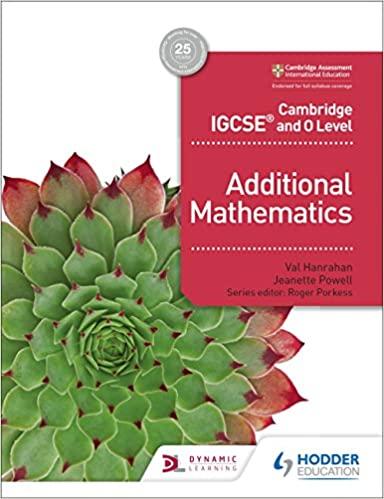Question
1 A parameter is a measure of some characteristic of the ____________________, while a statistic is a measure of that same characteristic in a ____________________.
1
A parameter is a measure of some characteristic of the ____________________, while a statistic is a measure of that same characteristic in a ____________________.
2
Suppose I am studying the extent of involvement in extracurricular activities amongundergraduate students at Boise State. I select 200 students at random. I ask them to recordthe number of hours they spend per week in extracurricular activities. For each student, thenI have one score, total number of hours spent in extracurricular activities per week.
a. What is the population in question?
b. What is the sample in question?
c. What is the variable under investigation?
d. Based on the outcomes for the students whose extracurricular activity was measured, Imake some generalizations about the extent of extracurricular activities amongundergraduates at Boise State. What type of statistics (descriptive or inferential) wouldI use to make the generalizations?
3. A university professor wants to study the effects of a new meditation technique on testanxiety. The hypothesis is that meditation will reduce test anxiety better than other availableinterventions. The construct of test anxiety has been operationally defined in terms ofstudents' final grades in the course. Sixty Boise State freshmen volunteer to participate in thestudy this semester. The registrar asks these students to register for one of three classes - each with only 20 available seats. The researcher then decides which class gets which testanxiety intervention, as follows: Class A (Introductory Fingerpainting) - These students aretaught to meditate. Class B (Accounting) - These students are provided with anti-anxietytherapy. Class C (Organic Chemistry) - These students are prescribed medication.
a. What is the (intended) independent variable in this study?
Introduction to Statistics and Frequency Distributions
b. What is the dependent variable?
c. What is the confounding variable in this study?
4. Match each data description with the most appropriate scale for its measurement
_____ the weight of each Boise State football player a. interval _____ the IQ of each Boise State football player b. nominal _____ the jersey number of each Boise State football player c. ordinal _____ the class ranking of each Boise State football player d. ratio
Below are scores from a number of students who have completed Psychology 230 on a testknowledge of statistical principles.
76 59 53 72 40 62 39 72 55 66 62 36 68 30 66 32 73 55 34 50 76 56 73 48 62 36 34 78 33 67 47 65 41 38 62 33 74 64 51 30 35 73 43 70
5. Form an ungrouped frequency distribution table for the above data. Be sure to list everynumber from the highest to the lowest. If an intermediate number does not occur, show thefrequency as zero (0). Only include the score values and the frequency number.
6. Following the steps given below, construct a grouped frequency distribution table for theabove data on the back of this page. Include columns for: (a) the class intervals (b)frequency (c) proportion (d) percentage (e) cumulative frequency and (f) cumulativepercentage. To do so, work through the instructions given below. Give the answers to eachstep in your homework.
Step 1: Find the highest and lowest scores in the distribution. Then compute the Number ofPossible Integer Values = (highest - lowest + 1).
Step 2: Create 10 intervals: Divide the Number of Possible Integer Values found in Step 1 by10 and round this result to the nearest whole number, whether odd or even. This gives you thewidth of the interval to be used for this data set.
Step 3: Create interval that contains the lowest score in the data listed above. Thelower limit of this interval should be a multiple of the width of the class interval computed instep 2. Then count up until you have created an interval that contains a number of scores equalto the width computed in step 2.
Step 4: Repeat step 3 to create the remaining intervals. You should keep making intervals untilyou get to an interval that included the highest score in the distribution above. Present theintervals in a chart like that shown below. Make sure you put the interval with the lowestvalues (worst test scores) at the bottom of the chart, and the interval with the highest values (best test scores) at the top.
Step 5: Complete the remaining columns of the chart.
| Class Interval | Frequency (f) | Proportion (p) | Percentage Cumulative | frequency (cf) | Cumulative Percentage |
7. Make a frequency histogram of the above data. Be sure to make clear the location of the
limits of the bars. Bars should be at real limits of intervals. Be sure to label both axes.
8. Make a frequency polygon of the above data. Be sure to plot the points at the midpoints of the
intervals. Label both axes.
9. Here are fictitious data on the types of jobs Boise State students seek after graduation. Make
an appropriate graph of these data, a bar diagram. Be sure to label axes. Follow the instructions
for making bar diagrams described in the Handout. Explain why a bar diagram is appropriate for
these data.
Type of Job Sought f
Sales 79
Merchandising 28
Teaching 43
Office Work 56
Construction 7
Financial Consulting 13
Step by Step Solution
There are 3 Steps involved in it
Step: 1

Get Instant Access to Expert-Tailored Solutions
See step-by-step solutions with expert insights and AI powered tools for academic success
Step: 2

Step: 3

Ace Your Homework with AI
Get the answers you need in no time with our AI-driven, step-by-step assistance
Get Started


